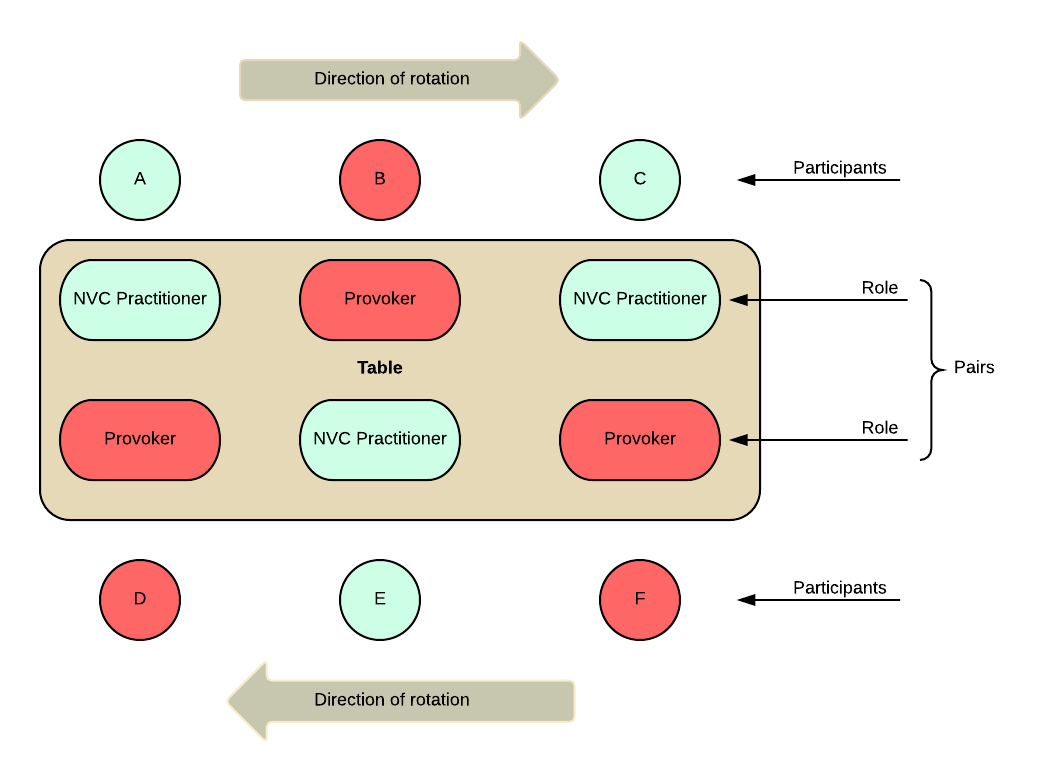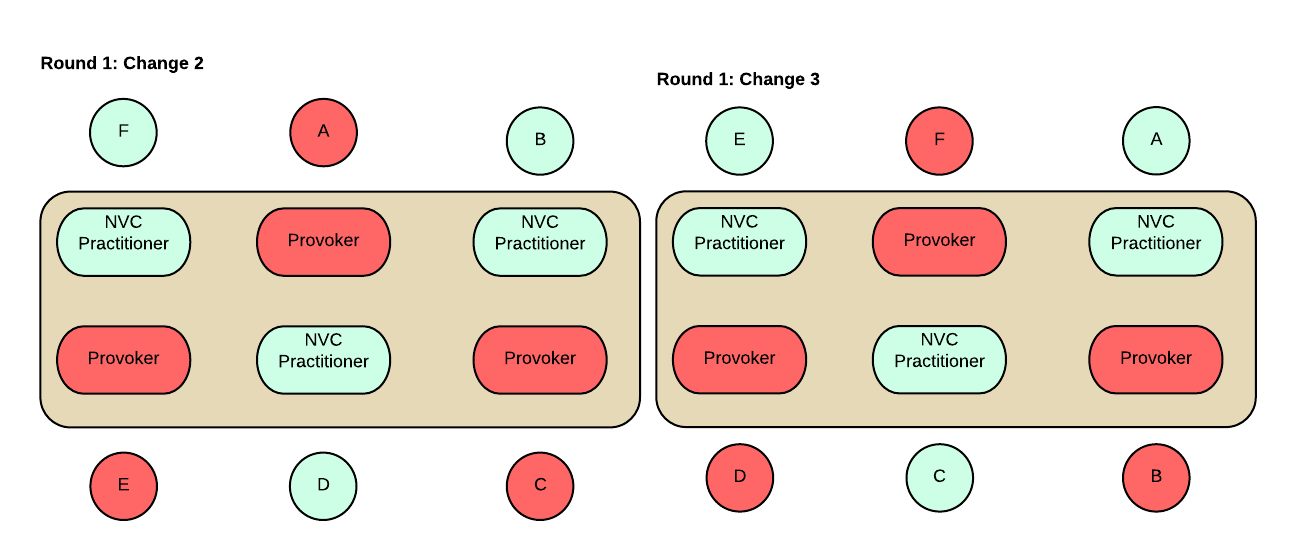A week ago I attended one of the best Agile conferences I know, Play4Agile. It’s a great conference in many ways, and especially because people there are open for experimentation. So, I experimented there with my idea of practicing NVC by using kata format from martial arts (if you are not familiar with the concept of kata, check this article from wikipedia). I have actually created a kata, but it was intended to be used alone and not in groups. My first two attempts did not work as well as I would have liked them to. Luckily they inspired David Schmithüsen and Roland Schöler to help me in development, and the third NVC kata I created with them was simply awesome.
In this blog post I’m going to share it with you with a few small adjustments. This guide is written for the facilitator of NVC kata. If you are just going to participate in NVC kata, not facilitate one, feel free to do so. There are no secrets.
Motivation
The motivation behind this kata and all NVC katas I have created is an internal conflict. I’m well aware that the use of NVC would help me to resolve conflict situations better than I do currently. However, when I’m in midst of fire, its really hard to apply NVC. NVC requires a lot of analytical thinking and skillful language. I have no problems in applying it when I’m relaxed. But when I am in stress my abilities for analytical thinking and skillful use of language are badly severed. That’s typical for humans: that’s how our mind works in a stressful situation.
This is where martial arts come into picture. When you need to defend yourself from an attack, you cannot think analytically about what to do. You need to have a set of proper reflexes in place. This is exactly what I need: proper reflexes for communication especially in stressful situations.
Structure of Kata
Reserve at least one hour for this kata. If you’re doing this for the first time, it’s good idea to reserve 1½h. In addition to the participants who exercise NVC in this kata, you need to have a facilitator. Facilitator takes care of the flow of practice,organizes a place for training, and takes care of that there are a sufficient amount of BANGs, flammable one liners that initiate a situation where NVC is applied.
The overall out line of the exercise is following:
- Introduction (5-10 mins)
- Very short intro to NVC if needed
- Motivational speech on the training format
- Setup speed-dating situation.
- The actual kata: at least 4 rounds, 4 changes in each round. (50-60 mins)
- Debriefing (5-15 min)
Before “3. the actual kata”, you may ask participant to brainstorm BANGs and put them in order. Reserve at least 20 minutes for this. Alternatively you may prepare BANGs before the kata session alone or with a participant of the kata.
Introduction - NVC is alike a right jab of boxing
I won’t tell here how to introduce NVC. If you are going to facilitate a kata, you should know how to do it. I just tell, how I introduce the training format. If this introduction doesn’t work for you, create your own variation of it, or read this aloud to participants as my (Ari-Pekka) motivation speech:
“One of the insights that helped me to understand the very idea of Non-violent communication (NVC from now on) was analogy between it and a right jab of boxing. Believe or not, they are very similar if you think of the logical structure behind action.
Without any practice people tend to use only their hand’s muscles when they strike a right jab. It is not very efficient because hand’s muscles are small, and thus you cannot get much power out of them, and in addition, you get tired quickly. So, first thing you are taught in a boxing school (or in my case, Savate basic course) is that the power of jabs comes from body rotation and from the big muscles of your torso.
Once you get the idea of swinging your torso in order to get power for your strike, they teach that you should just keep the muscles of your hand and shoulder relaxed and use them for steering only: think that you throw your fist through a pipe toward the target. At last, they point out that you should have good, balanced stance because of the law of force and counterforce: thus your right leg should be behind left leg (presuming you’re are right-handed and want to do this technique in right-handed way) and they should be horizontally far enough from each other.
In NVC the learning process and reasoning are pretty much the same. Without any practice people tend to think that the power of their words is in logical reasoning. In some cases it might be so, but if emotions are in play logical reasoning is not the best option: logical reasoning does not have big impact on emotions. In addition, when using only logical reasoning in a conflict situations, you get tired quickly, because “the other does not get you”.
So to say, empathy muscles of the solid logics behind your words are weak. In order to make your words also emotionally powerful you need to build them on shared understanding and listening. In NVC you build shared understanding by expressing facts in neutral way without judgement or evaluation so that the other person can easily accept them and becomes aware of that you have listened what he had said. In NVC jargon this is called “observation”.
After you get the idea that the power of your words comes from the big empathy muscles of shared understanding and listening, and not from the small muscles of logical reasoning, you can proceed to next step: How to use the empathy muscles of logical reasoning to channel the force of shared understanding and listing. In practice, you need to figure out what feelings and needs relates to the situation.
According to Rosenberg (creator of NVC) feelings reflects match and mismatch between our needs and the observed of situation. If it seems that your needs are not met, we feel fear, anxiety, solitude and other negative feelings, and if your needs are met we feel joy, excitement, togetherness and other positive feelings. So, in order to turn negative emotion to positive ones, and resolve a conflict we have to address the needs. In NVC you do this in two parts, first you identify the feelings that relate to the situation, and then you identify needs by using feelings as guide signs. NVC uses term of “Feelings” and “Needs” to refer to this.
At last, you put everything together to make such a request that allows the other either to affirm, to decline or both partially affirm and partially decline. “Necessities” and “the only one right answer” are indicators of bad empathic balance. If the other doesn’t affirm your proposal, you easily lose your empathic balance, and it takes needlessly long to propose another way to resolve conflict. In NVC jargon this last part is called “Request”.
The analogy between NVC and a right jab should be clear now: Listening and building shared understanding (“Observation”) is similar to body rotation of a right jab. Idea of using the muscles of your hand for steering only is same than the idea of using logical thinking to address correct needs in NVC (“Feelings” and “Needs” phases in NVC). At last getting good stance in order to not lose balance due Newtons’ third law has similar function than making request instead of demand in NVC.
Now we are going to train NVC in a similar way you would exercise a right jab in boxing school: first we practice to get power from body rotation, then we add throwing your hand toward the target and at last we pay attention to your stance so that you don’t lose your balance.
Setup speed-dating situation
After your motivational speech, organise space so that is easy for people to change pairs during the kata and check what their role is at any time. It’s a good idea to do some parts of the preparations before the session.
For instance if you have six practitioners, use the following way to organize seats around a table:

Image 1. Room setting for six participants.
After people have founded their seats explain the roles of the kata and the idea of changing pairs:
- You train as pairs with the person sitting at the opposite side of the table.
- One of you will be the provoker. His/her role is to say something nasty that creates a conflict.
- The person sitting at the opposite side of the table is NVC practitioner. His/her task is to use NVC techniques as a reply to the the provoker’s words.
- Your role will be marked in front of you on the table, so that it is easy to remember what is your role.
- We will change pairs often. When I say change, change seats clockwise. On the change you’ll have different pair and role. (See image 2)

Image 2. On changes, everyone changes places in clockwise order.
How to run the kata
The efficiency of kata is based on repetition. You surely don’t need this much repetition to learn idea of NVC, you need repetition to build correct kind of communication reflexes.
For first time you should have at least four rounds, and each round have four changes. Once people are familiar with NVC and this training format you can vary the amount of rounds and the changes during a round.
The structure of the round is following: 1. Introduce available techniques and variation and introduce the new one. 2. Introduce a BANG for the round. 3. Execute kata (4 changes) 4. Round debriefing
The first round is and should be very simple and have just one techniques. The each round adds one more technique (see image 3).

Image 3. This diagram outlines the content of the four rounds of the basic speed-dating kata I describe in details below. The basic kata has four rounds and the techniques are simplified versions of NVC’s four basic components: Observation, Feelings, Needs and Request.
1. Introduce available techniques and variation and introduce the new one.
If this is the first round, tell participants that the idea is to start with something very simple and then add complexity step by step. On the first round you have just one thing to think about, “observation”, on second round you have to do “observation” and “feelings” and at last on fourth you have all four components of NVC available.
Embrace simplicity. Don’t try to give all related theory or advices to the first timers relating steps of NVC - it’s too much. For first timers good level of details is:
- First round: Observation - “Rephrase the facts” + a spoken example
- Second round: Feelings - “What are my feelings? What are the other’s feelings?” + a spoken example
- Third round: Needs - “What are my needs? What are the other’s needs?” + a spoken example
- Fourth round: Request - “Formulate a (win-win) request to change the situation. Don’t /demand/ a change!” + a spoken example
2. Introduce a BANG for the round. Read it aloud and share it in small notes with the persons in the provoker’s role.
If this is the first round introduce also concept of BANG. BANG is a flammable one liner that initiates the conflict. E.g. “This is a neat idea, but it does not work here.” Each change starts so that the provoker plays BANG. The provoker may variate a bit to make it sound a bit more natural. After that NVC practitioner reacts, e.g. by rephrasing facts: “So, you think that there is something good in this idea, but you also don’t believe that it works here.”
In the end of this blog post there are listings of good BANG and instructions how to create a good BANG.
3. Kata (4 changes)
If this is the first round tell that participants will have 30-60 second time to play the discussion. After 30-60 second you will shout “cut and change”. If participants were in the middle of a sentence, it’s ok. Instruct them to just change pairs.
The actual duration for round varies depending on how many techniques NVC practitioner have and how much experience they have on NVC. For first timer, I recommend following durations:
| Available techniques | Duration of a change |
|---|---|
| Observation | 30s |
| Observation, Feelings | 40s |
| Observation, Feelings, Needs | 50s | Observation, Feelings, Needs, Request | 60s |
4. Round debriefing
After 4 changes ask what participants notices, how it felt and what was difficult? You may tell a bit more of theory as a response to the comment, but try to be concise. You also may give tips for the techniques. E.g. you may tell that in observation phase you may just rephrase what the other just said.
5. Session Debriefing
The intention of debriefing is to guide participants through what they did learn and how they could apply this in their life. There is not one right way to do this. The simplest way is to just ask:
- What did you learn from this kata?
- Do you think that this could be helpful in your everyday life? How?
Appendix: How to create a good BANG!
When preparing for BANGs start by thinking about your target group. Customize BANGs for them. You might need a person from the target group to help you.
Criteria for a good BANG are:
- Its clear and easy believable (someone could say something like that).
- It creates strong feelings
- It contains generalization, insult or bias
Avoid strong insults (“You suck! Please, go away!”). Usually a conflict starts with something less offensive and strong insults take place once there’s nothing more to say. BANG should contain an equal option to react in both violent way or non-violent way, and a real change to turn a conflict into mutual understanding.
E.g. in Play for Agile my target group was agile and lean coaches. My list of BANGs was following:
- “This GANTT chart is stupid. We don’t need to plan!”
- “There is no ROI in your retrospective. This tree hugging must stop.”
- “I dont want to participate in retrospective or any other Agile bullshit meetings.”
- “This is a neat idea, but it does not work here.”
These BANGs probably wouldn’t have worked for another target group.
Acknowlegement
In addition to the co-contributors David Schmithüsen and Roland Schöler, I’d like to thank Dana Pylayeva, Tero Kadenius and Antti Kirjavainen for good comments and editorial help, and Daniel Hommel for encouraging me to publish this and all those who participated test sessions in Play4Agile.
At last feel free to modify and use this as you will. If you mofify this, it would be great if you could share your version as well and inform me, but you don’t need to. Lisense: CC 4.0 BY.

